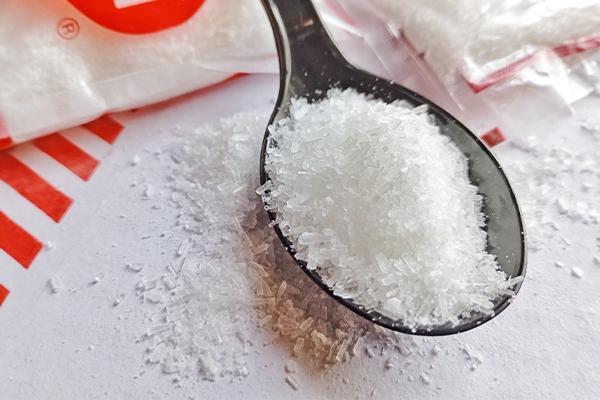Is MSG Bad for Your Health? Let’s Find Out

No one wants to admit it, right? But look at your favorite snacks—potato chips, fried meatballs, fried chicken, French fries—they probably all contain MSG (monosodium glutamate).
MSG often gets a bad rap when it comes to “unhealthy” food. But is its bad reputation deserved? Or is it just a myth? Let’s find out!
What is MSG and where does it come from?

MSG, or monosodium glutamate, is a food additive that enhances umami flavor—the savory taste known as the fifth basic taste after sweet, sour, salty, and bitter. Umami makes food taste more decadent and more delicious.
MSG is a white, odorless crystal widely used in the food industry, both in restaurants and packaged products. While it’s often associated with Chinese or Southeast Asian cuisine, it is used across a wide range of culinary traditions worldwide.
Seasonings like salad dressings, mayonnaise, ketchup, and barbecue sauce often contain MSG, as do packaged spice blends, frozen pizza, and instant noodles.
MSG is derived from L-glutamic acid, an amino acid naturally found in foods like tomatoes, cheese, meat, and mushrooms.
On an industrial scale, MSG is produced through the fermentation of carbohydrate-rich ingredients such as starch, sugar beets, sugar cane, or molasses.
The substance was first introduced in 1908 by Japanese chemist Kikunae Ikeda, who extracted glutamate from seaweed broth to create the first synthetic form of MSG. Since then, it has evolved into a widely used food additive.
Is MSG safe to eat?
This question comes up frequently, and the answer is yes, MSG is safe to consume in reasonable amounts.
Major international health organizations have confirmed MSG’s safety. The FAO/WHO Joint Expert Committee on Food Additives (JECFA), the U.S. Food and Drug Administration (FDA), and the European Food Safety Authority (EFSA) all classify MSG as Generally Recognized As Safe (GRAS) for consumption.
The FDA still requires manufacturers to list MSG on food labels, including naturally occurring forms like yeast extract, hydrolyzed yeast, or isolated proteins. This transparency helps inform consumers, especially those sensitive to MSG.
The benefits of MSG: more flavor, less sodium
MSG isn’t just about flavor—it also has a hidden benefit: it can help reduce salt intake.
Let’s compare:
1 teaspoon of salt = approx. 2,300 mg sodium
1 teaspoon of MSG = approx. 500 mg sodium.
This means MSG can be a helpful alternative for people on low-sodium diets, such as those with high blood pressure or heart conditions—allowing them to enjoy tasty meals without the excessive salt.
Why is MSG still seen as “bad”?

There are several reasons MSG continues to be misunderstood and feared, mainly due to past controversies and potential side effects, such as:
- Chinese Restaurant Syndrome
Some people have reported symptoms like headaches, facial flushing or warmth, sweating, and chest pain after eating food with MSG.
This reaction became known as “Chinese Restaurant Syndrome.” However, studies have shown that such symptoms are infrequent and typically only affect highly sensitive individuals to large amounts of MSG. - Linked to obesity
MSG may influence hunger-related hormones and potentially lead to overeating.
However, findings have been inconsistent, and more studies are needed before drawing solid conclusions. - Effects on the brain
MSG contains glutamate, a type of neurotransmitter.
There have been concerns that excessive glutamate may overstimulate brain cells (a process called excitotoxicity).So far, no substantial evidence exists that dietary MSG causes human brain damage. - High sodium content
It’s important to note that MSG-rich foods—like fast food, processed snacks, or instant soups—are often high in total sodium overall.
The focus should be on maintaining a balanced diet rather than blaming MSG alone.
Innovative ways to consume MSG
If you’re sensitive to MSG or just prefer to limit your intake, here are some practical tips:
- Read food labels: MSG may appear under different names, such as monosodium glutamate, yeast extract, or hydrolyzed vegetable protein.
- Cut back on processed and fast food.
- To enhance flavour, use natural sources of umami, such as ripe tomatoes, mushrooms, soy sauce, and Parmesan cheese.
**
MSG isn’t poison—nor is it the root cause of every health problem, as it was once made out to be.
Consuming vast amounts of MSG might trigger temporary, uncomfortable symptoms, but within reasonable limits and as part of a balanced diet, MSG is a safe flavor enhancer. It may even lower overall sodium intake.
So, you don’t have to avoid your favorite foods out of fear. The key is moderation and balance—as the old saying goes, too much of anything is never good.



